Smart business owners understand that securing funding is only half the battle. The real challenge lies in deploying that capital strategically to build sustainable, long-term growth rather than quick fixes that drain resources.
Essential Working Capital Strategies for Growth

Implementing essential working capital strategies for growth requires a systematic approach to managing your business finances. Effective working capital management helps businesses optimize their cash flow while maintaining the liquidity needed for expansion opportunities.
- Optimize payment cycles: Negotiate better terms with suppliers while encouraging faster customer payments. This approach may improve your cash conversion cycle and free up capital for growth initiatives.
- Strengthen supplier relationships: Building solid partnerships with vendors can lead to more favorable payment terms and bulk purchasing discounts. These relationships often provide flexibility during expansion phases when cash flow fluctuates.
- Monitor cash flow patterns: Regular analysis of your cash flow cycles helps identify seasonal trends and potential shortfalls. This insight enables better planning for funding needs and growth timing.
- Align funding with objectives: Match your financing strategy directly with specific growth goals rather than general business needs. Revenue-based financing might work well for businesses with predictable income streams looking to expand operations.
Strategic Financial Planning for Business Success
Strategic financial planning for business success involves creating a comprehensive framework that aligns your funding decisions with long-term objectives. This approach helps ensure that every dollar invested contributes to sustainable expansion rather than short-term gains.
- Build financial resilience: Develop strategies that prepare your business for market changes and economic fluctuations. Agile financial planning enables companies to adapt quickly while maintaining growth momentum during challenging periods.
- Focus on capital structure optimization: Balance debt and equity financing to minimize costs while maximizing growth potential. The right mix depends on your industry, growth stage, and risk tolerance.
- Integrate cost efficiency measures: Identify areas where operational improvements can reduce expenses without compromising quality. These savings can then be redirected toward strategic growth investments.
- Create scalable systems: Invest in processes and infrastructure that can handle increased volume without proportional cost increases. This foundation supports sustainable expansion as your business grows.
Steps to Maximize Funding Impact
Following specific steps to maximize funding impact can significantly improve your return on investment and accelerate sustainable growth. These structured approaches help businesses deploy capital more effectively.
- Conduct thorough market analysis: Research your target market conditions and competitive landscape before deploying funds. Understanding market dynamics helps ensure your expansion timing and strategy align with opportunities.
- Prioritize high-impact investments: Focus funding on areas that typically generate the strongest returns, such as technology upgrades, key personnel, or market expansion. Avoid spreading resources too thin across multiple initiatives.
- Establish clear performance metrics: Define specific, measurable goals for how the funding should perform. Regular monitoring allows for course corrections and ensures accountability in fund deployment.
- Build contingency reserves: Set aside a portion of funding for unexpected opportunities or challenges. This financial cushion provides flexibility and may prevent the need for emergency financing later.
- Review and adjust regularly: Schedule periodic assessments of funding performance against your growth objectives. Markets change, and your strategy might need refinement to maintain effectiveness.
Best Practices for Working Capital Management
Implementing best practices for working capital management creates the foundation for sustained business growth and improved financial health. These practices help optimize the relationship between short-term assets and liabilities.
- Streamline accounts receivable: Implement efficient collection processes and consider offering early payment discounts to customers. Faster collections improve cash flow and reduce the risk of bad debt.
- Optimize inventory levels: Balance having enough stock to meet demand while minimizing carrying costs. Just-in-time inventory systems or demand forecasting tools might help achieve this balance.
- Manage accounts payable strategically: Take advantage of payment terms without damaging supplier relationships. Pay early only when discounts make financial sense, otherwise use the full payment period to preserve cash.
- Leverage technology for efficiency: Automated invoicing, payment processing, and financial reporting systems can reduce administrative costs and improve accuracy. These improvements often free up resources for growth-focused activities.
- Monitor key ratios regularly: Track working capital ratios, cash conversion cycles, and liquidity metrics to identify trends early. This monitoring helps prevent cash flow problems that could derail growth plans.
Strategic use of business funding requires careful planning, disciplined execution, and ongoing monitoring. By focusing on working capital optimization, aligning financial strategies with growth goals, and implementing proven management practices, businesses can transform funding into sustainable competitive advantages that drive long-term success.

.png)






